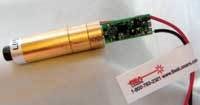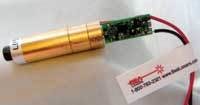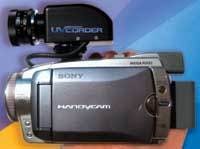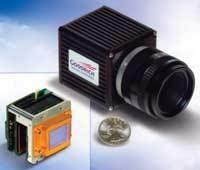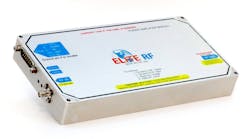Bright future seen for diamond in laser and LED applications
Officials of sp3 Diamond Technologies Inc., a supplier of diamond film products in Santa Clara, Calif., say testing has demonstrated the feasibility of the company’s DiaTherm diamond heat spreaders for laser packages and light-emitting-diode (LED) devices. The decrease in device junction temperature achieved by the increased thermal conductivity of DiaTherm allows manufacturers to design improved device reliability margin or longer lifetime with increasing laser and LED optical power by up to 300 percent. DiaTherm offers thermal conductivity three times that of copper, a common heat sink, and five times greater than aluminum nitride (AlN) or beryllium oxide (BeO), common heat-spreaders. These values equate to higher brightness, closer spacing and longer lifetimes for LED devices and higher laser power with the same device reliability. Replacement of copper heat-spreaders used in bright LED devices with DiaTherm enables an increase in LED optical-power output of more than 200 percent at the same junction temperature. DiaTherm fits directly in LED device assembly processing with solder attachment to the LED die and PCB or heat sink. Cost increase for replacement of copper heat-spreaders with DiaTherm is relatively small as the CVD diamond heat-spreaders have an unmetallized price of about $1.5 per cubic millimeter. For more information contact sp3 Diamond Technologies online at www.sp3inc.com.
Low-cost line of green laser-diode modules
Officials of BEA Lasers Inc. in Elk Grove Village, Ill., are offering a line of low-cost, long-life green laser-diode modules for robotic control, positioning applications, particle measurement, spectroscopy, medical tissue analysis, inferometry, holography, and other applications. The model 2501 is a fixed-focus continuous-wave diode-pumped laser-diode module with a beam divergence of less than 1.2 mrad. The laser housing is 11 millimeters in diameter and is 38 millimeters long. For more information contact BEA Lasers online at www.bealasers.com.
Image sensors from e2v help NASA to study new horizons
CCD (charge coupled device) imaging devices from e2v technologies in Elmsford, N.Y., are aboard NASA’s New Horizons mission to Pluto. The sensors, which are part of the spacecraft’s Ralph and LORRI science instruments, will help to provide image data on the planet. New Horizons will collect key information on the surface, composition and atmosphere of Pluto and its orbital companion Charon. Officials at e2v technologies supplied a total of 27 CCDs for the spacecraft’s Ralph instrument, five of which were flight devices. These sensors will enable high-resolution mapping of Pluto and Charon’s surfaces. The visible and infrared Ralph spectrometer will provide composition, color and thermal maps for scientific analysis. Additional e2v sensors in the telescopic camera LORRI, the spacecraft’s Long Range Reconnaissance Imager, will help to provide extremely high resolution and highly detailed images of Pluto, its large moon Charon, and its two newly discovered smaller moons. Such scientific studies will provide world-first information on the Kuiper Belt planets, which survive billions of miles away from the Sun. New Horizons is the pioneer space mission in the NASA New Frontiers program. The robotic space flight mission will span the solar system on its one-way journey, reaching Pluto for flyby investigations in 2015. En route, a flyby at Jupiter early next year will enable a practice science run to be carried out, in preparation for the Pluto assignment. For more information contact e2v online at www.e2v.com.
Army recognizes Physical Optics Corp. for wireless personal information carrier
Physical Optics Corp. in Torrance, Calif., won a U.S. Army award for one of the Army’s 10 greatest inventions for an electronic information carrier (EIC) that Physical Optics developed as a dog-tag-size wireless personal information carrier system (WPIC), which is pronounced “Y-Pick.” Officials of the U.S. Department of Defense (DOD) reviewed the designs in July 2004, and Physical Optics was one of two companies given $750,000 contracts to continue developing the WIPC systems, which now is available for military, government, and commercial customers. The WPIC can contain as much as 20 years of medical records, giving medical personnel access to data without the need for physical contact. Compression technology from Physical Optics is an element in the WPIC’s ability to store, read, and transmit medical files, images-including radiographic and ultrasound-and audio/video data without noticeable loss of resolution. The records, including allergies, blood type, doctors’ comments, and audio/visual files, can transmit securely as far away from the patient as 10 yards. For more information contact Physical Optics online at www.poc.com.
Ultraviolet camcorder available from Oculus Photonics
Officials of Oculus Photonics LLP in Goleta, Calif., are offering a digital near-ultraviolet camcorder called the UVCorder, which the company developed in response to the need for digital imaging in this band. The unit displays near-UV images in real time on a 3.5-inch liquid-crystal display. The unit can also acquire near-UV digital video and stills. The ultraviolet camera module has enhanced UV response in the 300- to 400-nanometer range, with a peak response at 370 nanometers, with rejection of visible light. The module is mounted on a commercial camcorder, from which it receives power. Applications include camouflage detection, forensics, building inspection, ultraviolet laser alignment, dermatology dentistry, biological research, and industrial surface inspection. For more information contract Oculus Photonics online at www.ultravioletcameras.com.
Shortwave IR camera for military and commercial uses
The Sensors Unlimited, Goodrich Corp. in Princeton, N.J., is offering shortwave infrared camera SU320KTX-1.7 RT, which is smaller than 3.8 inches long and weighs less than 3.1 ounces. Developed originally for the U.S. Army Soldier Mobility and Rifle Targeting System, the camera is available for industrial and commercial use. The camera is for low-light conditions and day/night operation. Its indium gallium arsenide KTX sensor offers wide dynamic range imaging in partial starlight to direct-sun illumination. The KTX camera has high sensitivity available in the 900-to-1700-nanometer wavelengths with a 320-by-240-pixel format on a 40-micropitch focal-plane array. The camera uses less than 1.6 watts, is all-solid-state, operates at room temperature, and has onboard nonuniformity corrections. Target applications are surveillance, robotics, and handheld systems. Contact Sensors Unlimited at www.oss.goodrich.com.
